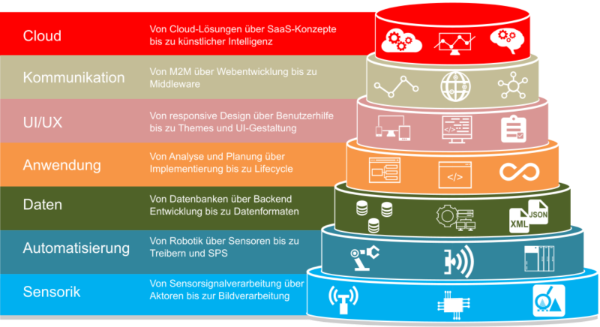SystemC TLM in Full-Stack IoT Development: A White Paper
Introduction
The Internet of Things (IoT) has witnessed an explosive growth in recent years, driven by advancements in hardware, software, and networking technologies. As IoT devices become more complex and interconnected, the need for efficient and scalable development methodologies becomes increasingly critical. SystemC Transaction Level Modeling (TLM) offers a promising approach to address these challenges by providing a high-level abstraction for modeling and simulating complex systems, including IoT devices and their associated infrastructure.
SystemC TLM Fundamentals
SystemC TLM is a modeling methodology based on the SystemC language, which is a C++-based language for system-level design and verification. TLM provides a set of constructs and guidelines for modeling system components as transactions, which represent the interactions between components. This abstract view allows for faster simulation and easier integration of different components, regardless of their underlying implementation details.
Key Benefits of SystemC TLM in IoT Development
-
Rapid Prototyping and Simulation: TLM enables rapid prototyping and simulation of IoT systems, allowing for early identification and correction of design flaws.
-
Platform Independence: TLM models are platform-independent, making them suitable for heterogeneous IoT environments that may include devices with different hardware and software configurations.
-
Reusable Components: TLM components can be reused across different IoT projects, reducing development time and effort.
-
Interoperability: TLM promotes interoperability between different IoT components and systems, facilitating the integration of diverse technologies.
-
Verification and Validation: TLM can be used to verify and validate IoT systems against functional, performance, and security requirements.
Application Areas of SystemC TLM in IoT
-
IoT Device Modeling: TLM can be used to model IoT devices such as sensors, actuators, and gateways, capturing their functional behavior and interactions with the surrounding environment.
-
Network Modeling: TLM can be used to model IoT networks, including communication protocols, routing algorithms, and security mechanisms.
-
Cloud Platform Modeling: TLM can be used to model cloud platforms that support IoT applications, such as data storage, processing, and analytics.
-
End-to-End System Modeling: TLM can be used to model end-to-end IoT systems, from device-level interactions to cloud-based applications.
Challenges and Considerations
-
Complexity: TLM can be complex to use for large-scale IoT systems, requiring a deep understanding of the methodology and the underlying SystemC language.
-
Performance: TLM simulations can be computationally expensive, especially for complex models and large-scale systems.
-
Tool Support: While there are several SystemC TLM tools available, their maturity and support for IoT-specific features may vary.
Future Directions
-
Integration with IoT Standards: TLM could be integrated with IoT standards such as MQTT, CoAP, and LWM2M to facilitate interoperability and standardization in IoT development.
-
Real-Time Capabilities: TLM could be extended to support real-time modeling and simulation, which is essential for IoT applications with stringent timing requirements.
-
AI and Machine Learning Integration: TLM could be integrated with AI and machine learning techniques to enable intelligent IoT systems that can adapt to changing conditions and learn from their experiences.
Conclusion
SystemC TLM offers a powerful and versatile approach to full-stack IoT development. By providing a high-level abstraction for modeling and simulating complex systems, TLM can help accelerate the development of IoT devices, networks, and applications. While there are challenges to be addressed, the potential benefits of TLM in IoT development make it a promising technology for the future.
References
General SystemC TLM References
-
SystemC Language Reference Manual. Accellera Systems Initiative.
-
SystemC Transaction Level Modeling (TLM) 2.0 Standard. Accellera Systems Initiative.
-
SystemC TLM for Embedded Systems. Andreas Gerstner. Springer.
-
SystemC Verification: A Practical Guide. Graham Martin. Springer.
IoT-Specific References
-
Internet of Things: A Comprehensive Overview. Raj Kamal. Springer.
-
IoT Architecture and Design. David Evans and Matthew Johnson. O'Reilly Media.
-
IoT Security: Principles, Technologies, and Solutions. Sudip Mittal and Amit Ray. CRC Press.
-
IoT Platforms and Protocols. Ian Dobson. Apress.
Cloud Computing and IoT References
-
Cloud Computing: Principles and Paradigms. Rajkumar Buyya, Chee-Yam Chan, and S. Thareswari. Wiley.
-
Cloud Computing for IoT: A Practical Guide. Raj Kamal. Springer.
-
IoT and Cloud Computing: A Synergistic Approach. Amit Kumar and Rajeev Kumar. CRC Press.
AI and Machine Learning in IoT References
-
Artificial Intelligence for IoT. Raj Kamal. Springer.
-
Machine Learning for IoT Applications. Sudip Mittal and Amit Ray. CRC Press.
-
Deep Learning for IoT. Raj Kamal. Springer.
Note: This is a suggested list of references. You may need to consult additional sources based on your specific research interests and the depth of coverage required for your paper. Contact ias-research.com for details
